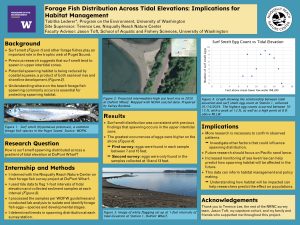Forage Fish Distribution Across Tidal Elevations: Implications for Habitat Management
Forage fish play an essential role in the trophic flow of marine ecosystems, as a food source for culturally and ecologically important species, such as salmon and marine mammals. Their role makes forage fish species, like surf smelt and Pacific sand lance, indicator species for the ecosystem health of Puget Sound. However, as sea level rise and shoreline development increase, the shoreline habitats that forage fish need for spawning are being reduced. My research aimed to determine how tidal elevation influences forage fish spawning distribution at DuPont Wharf, Washington. I worked with the Nisqually Reach Nature Center to collect sediment samples and analyze them to find forage fish eggs and map their distribution patterns along the shoreline. The findings indicate that surf smelt distribution is concentrated at higher tidal elevations, with a peak at 12 feet above mean lower low water; the results on sand lance distribution were inconclusive. More research is required to support these conclusions and find more influences on spawning distribution. Distribution data can be used to inform habitat management and influence decision-making about shoreline development and conservation in Puget Sound.
